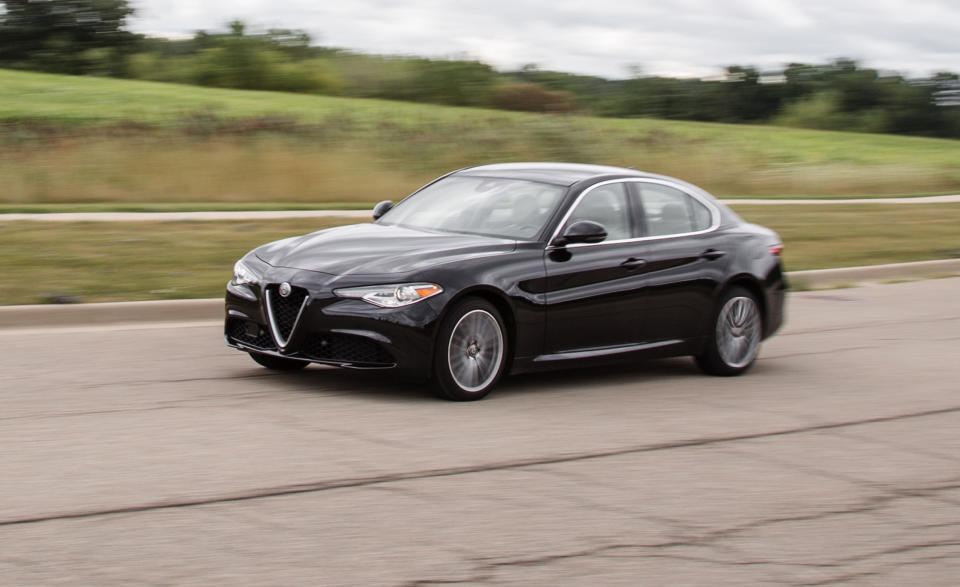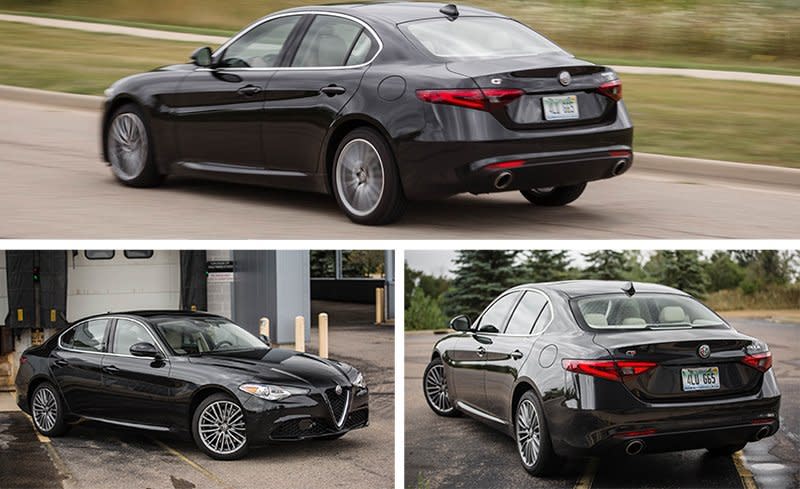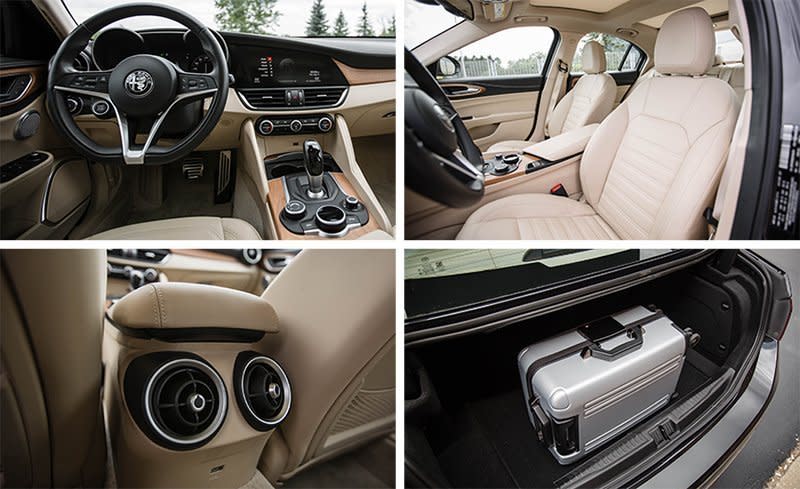2017 Alfa Romeo Giulia 2.0T AWD

Momentarily set aside the 505-hp snarl of the Alfa Romeo Giulia Quadrifoglio’s Ferrari-derived V-6, and even the mainstream 2017 Giulia sedan presents as a stylish, back-road charmer when properly equipped with its available chassis upgrades. Attractive and capable as it may be, though, in its standard configuration and with the added heft of all-wheel drive, this Alfa leaves the Italian marque’s anima feeling a touch soft.
Opting for a second driven axle on the Giulia inflates its base price by $2000, to $40,990. As with the rear-drive example we previously tested, our AWD test car was of the Alfa’s grander Ti spec, which tacks on another $2000 over the base trim and brings several standard and optional equipment groups. Notably absent, however, was the Ti’s $2250 Sport package with 19-inch wheels, which fits the car with a Quadrifoglio-aping tracksuit and replaces the Ti’s 18-inch wheels and all-season rubber with larger, staggered-width performance tires. (An 18-inch Sport package brings similar aesthetics sans the upgraded footwear.) Also missing was the Ti’s $1200 Performance package and its adaptive dampers, limited-slip rear differential, and column-mounted aluminum paddle shifters. Compared with the rear-drive car that featured both equipment upgrades, this 3660-pound AWD example was only 24 pounds heavier.

Not-So-Fancy Footwear
All non-Quadrifoglio Giulias sport a turbocharged 2.0-liter inline-four mated to a smooth and well-sorted eight-speed automatic transmission. Output is a hearty 280 horsepower, along with 306 lb-ft of torque that manifests with little lag at 2000 revs. Thanks to its greater traction off the line, our test car scooted to 60 mph in 5.5 seconds and covered the quarter-mile in 14.1 at 100 mph—beating the rear-drive Giulia 2.0T by 0.2 second in both measures. That’s still slightly off the pace of the four-cylinder Audi A4, BMW 3-series, and Cadillac ATS, yet it’s well ahead of a comparable Mercedes-Benz C-class. The all-wheel-drive Giulia’s fuel economy also lags behind that of most of its rivals, despite matching the previous test car’s 32 mpg on our 75-mph highway test and bettering it by 2 mpg overall with a 23-mpg average.
Chalk up most of this example’s greater efficiency to it simply being less rewarding to drive hard without the available performance upgrades. The meager grip supplied by the Ti’s standard 225/45R-18 Bridgestone Turanza EL450 all-season run-flat tires overshadowed any additional understeer at the limit from the AWD Alfa’s greater front-to-rear weight balance (52.0/48.0 percent versus the rear-driver’s 49.8/50.2). Compared to the rear-drive car with its stickier 19-inch Pirelli P Zeros, this Giulia’s 70-mph-to-zero stopping distance stretched from 163 feet to a lengthy 186. The modest rubber also conspires with a cautious, undefeatable stability-control system to rush to the rescue in corners well before the Alfa’s chassis has quit the fight—limiting it to just 0.79 g on the skidpad versus the previous car’s 0.88 g.
Curb your gusto behind the thin-rimmed steering wheel and the standard Giulia feels taut and composed yet rides impressively well on its standard dampers. While the less aggressive tires remove some of the crispness from the Alfa’s talkative helm, its steering firms up nicely with the DNA driving-mode selector set to its D (Dynamic) setting. Left in its N (Natural) position, the car is calm and collected on the road, albeit without the fizz of the sportier mode’s heightened responses for the engine and transmission. Our major gripe is with Alfa’s brake-by-wire setup and the wooden, nonlinear feel it imparts in the brake pedal, particularly at around-town speeds.

Making an Alfa
The Giulia has an undeniably pretty shape, and the 20-spoke Lusso wheels on our test car lent it an additional shot of elegance. Its cabin also has the style and warmth to set it apart from the cold, tech-heavy environs of many luxury cars—even though this Alfa still has room to improve on fit and finish before it can rival Audi or Mercedes-Benz interiors. In lieu of performance options, our $51,490 example was loaded with more than $10K in extra luxuries, highlighted by the $2000 Ti trim upgrade, a host of active-safety features, and the $2250 Ti Lusso Light Wood package (the aforementioned 18-inch wheels, walnut wood trim, leather on the dash and upper door panels, eight-way power-adjustable front seats, and a flat-bottom steering wheel).
The Giulia sedan is a worthy and spirited ambassador of Alfa’s 21st-century reemergence in the U.S. market. But some augmentation is still required for it to be at its best. While the Giulia represents the warm and fuzzy alternative to conventional luxury that we expect from an Italian brand, one must spring for the handling upgrades to fully experience its character as an Alfa Romeo.
Specifications >
VEHICLE TYPE: front-engine, all-wheel-drive, 5-passenger, 4-door sedan
PRICE AS TESTED: $51,490 (base price: $40,990)
ENGINE TYPE: turbocharged and intercooled SOHC 16-valve inline-4, aluminum block and head, direct fuel injection
Displacement: 122 cu in, 1993 cc
Power: 280 hp @ 5200 rpm
Torque: 306 lb-ft @ 2000 rpm
TRANSMISSION: 8-speed automatic with manual shifting mode
DIMENSIONS:
Wheelbase: 111.0 in
Length: 182.8 in
Width: 73.2 in Height: 57.1 in
Passenger volume: 94 cu ft
Trunk volume: 13 cu ft
Curb weight: 3660 lb
C/D TEST RESULTS:
Zero to 60 mph: 5.5 sec
Zero to 100 mph: 14.1 sec
Zero to 130 mph: 27.4 sec
Rolling start, 5–60 mph: 6.7 sec
Top gear, 30–50 mph: 3.6 sec
Top gear, 50–70 mph: 4.3 sec
Standing ¼-mile: 14.1 sec @ 100 mph
Top speed (governor limited, mfr's claim): 149 mph
Braking, 70–0 mph: 186 ft
Roadholding, 300-ft-dia skidpad*: 0.79 g
C/D FUEL ECONOMY:
Observed: 23 mpg
75-mph highway driving: 32 mpg
Highway range: 480 miles
EPA FUEL ECONOMY:
Combined/city/highway: 26/23/31 mpg
*stability-control-inhibited

 Yahoo Autos
Yahoo Autos 